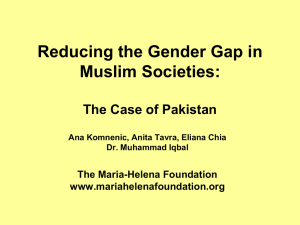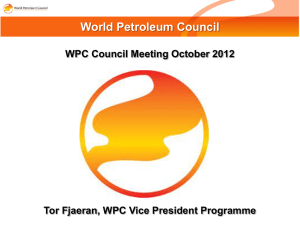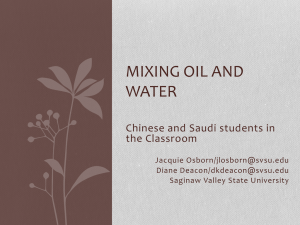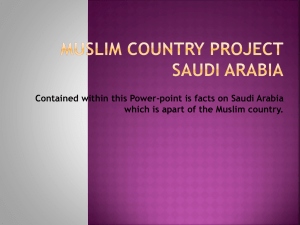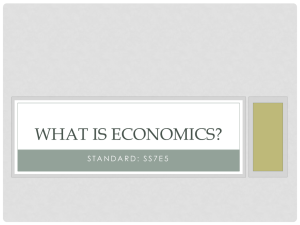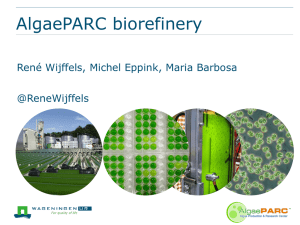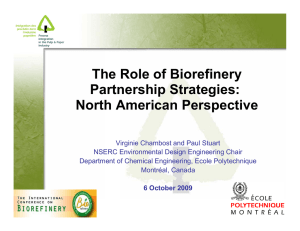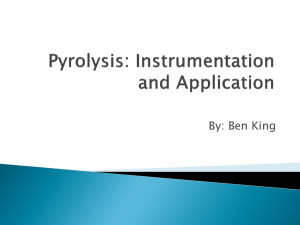Dr. Abdul Sattar Nizami
advertisement
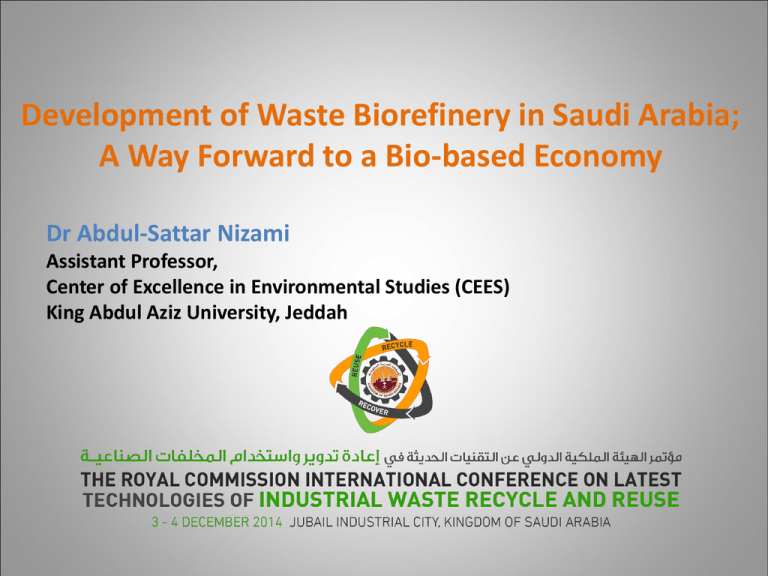
Development of Waste Biorefinery in Saudi Arabia; A Way Forward to a Bio-based Economy Dr Abdul-Sattar Nizami Assistant Professor, Center of Excellence in Environmental Studies (CEES) King Abdul Aziz University, Jeddah Postdoctoral Fellow in Bioproducts and Biofuels (2011- 2013) Dept. of Chemical Eng. & Applied Chemistry and Civil Eng., University of Toronto, Canada. PhD in Civil and Environmental Engineering (2008-2011) Green Grass: Developing Grass for Sustainable Gaseous Biofuel. University College of Cork (UCC), Ireland. Master of Science in Engineering (MScEng.) (2005-2007) Applied Environmental Measurement Techniques. Chalmers University of Technology, Sweden. Bachelor of Science B.Sc. (Hons.) (2001-2004) Environmental Sciences. University of the Punjab, Pakistan. o I have published 37 papers (19 peer reviewed journal papers with total impact factor of 80), 9 international conference papers, 5 book chapters with world leading publishers and a further 4 invited lectures). o My work has been cited over 600 times in the peer review press (H factor of 13). Research Interests o o o o Waste to energy and value added product system designing and assessment Life cycle and policy analysis of bioproducts and biofuels Designing anaerobic digestion systems Biomass and bioproducts: integrated biorefineries KING ABDULLAH CITY OF ATOMIC AND RENEWABLE ENERGY (KACARE) o Saudi Arabia was the world's 12 largest primary energy consumer in the year 2013. o The electricity demand of Saudi Arabia has increased 5.8% from 2006 to 2010. o The petroleum (60%) and the natural gas (40%) fulfils this demand. o The government has planned to double its energy generating capacity of 55 gigawatts (GW) to 120 GW by 2032. o A special program; King Abdullah City of Atomic and Renewable Energy (KACARE) to establish the renewable-energy sources through science, research and industries. o The ambition is to generate about half of the electricity capacity from different renewable sources such as solar, nuclear and waste to energy facilities by 2032. MUNICIPAL SOLID WASTE (MSW) OF SAUDI ARABIA o The MSW generation rate is 15.3 million tons per year and 1.4 kg per capita per day. o In the Riyadh, Jeddah and Dammam, the food, meat and vegetable wastes are exceeding 6 million tons per year. o Annually, 35-40% cooked rice is wasted with an estimated worth of 1.6 billion SR. o Makkah city landfills receive about 2-3 times more waste every day during the Ramadan and Hajj season than normal days. o During the 2007 Hajj, around 700,000 goats were slaughtered. o This year 2014's Hajj, more than 2.5 million animals were sold for slaughtering. o Around 2 million plastic Zam-Zam cups are wasted every day during the 2007 Hajj time. o In the first three days of 2014's Ramadan, 5000 tons of food was wasted only in Makkah municipality. o Collectively, about 600 tons of waste are generated each day during the Hajj and Ramadan time. NEED OF ENERGY RECOVERY FACILITIES IN SAUDI ARABIA Waste type Food waste Plastic Paper Cardboard Glass Wood Textile Metals Aluminium Leather Other Waste composition (mass %) 50.6 17.4 12.0 6.6 2.9 2.0 1.9 1.9 0.8 0.1 3.7 Total waste (million tons/year) 7.74 2.66 1.83 1.02 0.44 0.30 0.30 0.29 0.13 0.02 0.57 Generation rate (kg/capita/day) 0.71 0.24 0.17 0.09 0.04 0.03 0.03 0.03 0.01 0.00 0.05 o There is no waste to energy or material recovery facility existing. o All of the collected MSW is disposed in landfill untreated. o The problems of water contamination, waste leachate and sludge, and methane and odor emissions are occurring. o The benefits of generating bioenergy and bioproducts from the MSW are numerous such as o Opening new channels in renewable- energy science and research, o Solving kingdom's solid waste problems, o New businesses and job creation, o Minimizing environmental pollution, o Improving public health. ENERGY RECOVERY TECHNOLOGIES o The possibilities of converting the MSW to bioenergy are plentiful and can include a wide range of waste sources, conversion technologies, infrastructure and end-use applications. o The choice of conversion technology depends on the type and quantity of waste, end-uses of energy, environmental standards and economic requirements. o Several waste to energy technologies such as pyrolysis, anaerobic digestion (AD), transesterification, fermentation, gasification, incineration, etc. have been developed. o There are certain limitations in their use and applications. They have to compete with other fossil fuels and renewable-energy sources. Anaerobic digestion Pyrolysis Gasification Incineration Power plants use Transesterification Food waste Paper √ × × √ × √ √ × × √ √ × Wood × × √ √ √ × Garden √ × × √ × × Plastic × √ × √ √ × Cardboard √ × √ √ √ × Textile × × √ √ √ × Leather × √ √ √ √ × CONCEPT OF WASTE BIOREFINERY o None of the conversion technologies alone can achieve the zero waste concept and replace the fossil fuels. o There is a great need to bring different energy recovery technologies together, treating different fractions of municipal solid waste at one platform of waste biorefinery. o It is a multi-process and multi-product system, similar to petroleum refinery. o It provides bio-based products such as food, feed and useful materials and chemicals and bioenergy in the form of fuel, power and heat. o This new energy concept is particularly relevant in Saudi Arabia, where no waste to energy facility and bio-waste products exists. o There are different kinds of biorefineries, such as the green biorefinery, the whole crop biorefinery, lignocellulosic feedstock biorefinery and municipal or industrial waste biorefinery. CENTER OF EXCELLENCE IN ENVIRONMENTAL STUDIES (CEES), KING ABDULAZIZ UNIVERSITY WORK ON WASTE BIOREFINERY o The aim of the research at CEES is to develop a waste biorefinery in the Saudi Arabia to treat the different fractions of MSW for generation of renewable energy and value-added products. o The food, plastic and slaughterhouse waste along with used cooking oil will be treated by AD, pyrolysis, and rendering followed by transesterification technologies to produce biogas, fuel oil and biodiesel respectively at laboratory scale. o The overall ambition of this project is to meet the target set by the Saudi's government of producing half of the country's electricity from renewable resources by 2032, and to solve the Kingdom's solid waste problems at the same time. o A new set of guidelines will be prepared for the households, restaurants, hotels, parks, municipalities and technology developers, highlighting the concept of reduce, reuse, recycle and recover from the waste and segregation of waste at its source into different bins. SAUDI ARABIAN WASTE BIOREFINERY Feedstocks Plastic & wood Waste Conversion Pathway Thermochemical Conversion Processes Combustion Bioenergy Applications Hot gases Heat Gasification Syngas WASTE BIOREFINERY Electricity Pyrolysis Animal Waste, Usedoil & Fats Physicochemical Convesrion Rendering Bio-chemical Conversion Liquid Biofuels Lard, Tallowl Transesterification Organic fraction of MSW Fuel-oil, Syngas, Charcoal Fermentation Biodiesel Solid fuel Bioethanol Industrial Material Anaerobic Digestion Biogas Soil Conditioner WASTE PLASTIC TO FUEL-OIL o The plastic waste is required to recycle and recover to minimize operational and environmental problems of the landfill. o The use of incineration process for plastic waste has previously caused air pollution and negative health effects. o The conventional mechanical recycling methods such as sorting, grinding, washing and extrusion can recycle only 15- 20% of all plastic waste. o In pyrolysis process, waste plastic is decomposed thermochemically in the absence of air at temperatures of 400+ 0C and converted into liquid (fuel-oil), solid (charcoal) and gaseous (syngas) fractions. o The fuel oil is similar to diesel, with lower sulphur and higher cetane value. PYROLYSIS OF WASTE PLASTIC INTO FUEL-OIL o The fuel-oil production from pyrolysis of 1 kg of mixed plastics such as PP (Polypropylene), PE (Polyethylene) and PS (Polystyrene) plastics, is 0.75 litres fuel-oil (75% conversion efficiency). o The potential and utilization of naturally occurring zeolites in Saudi Arabia for pyrolysis catalyst is under investigation in CEES. ANAEROBIC DIGESTION OF ORGANIC FRACTION OF MUNICIPAL SOLID WASTE o The anaerobic digestion technology is very favourable for Saudi Arabia in producing biogas and organic fertilizer due to high organic nature (upto 75%) MSW. o Typically, each goat gives 1.5 litres of blood and 7 kg of solid waste after slaughtering, thus the thousand litres of blood waste during each Hajj season can also be treated in anaerobic digestion for biogas production. o The range of biomethane production of food waste is 314 to 529 L CH4 kg VS-1 added depending on the type of reactor and source of food waste. o The canteen and commercial food waste generated 480-530 L CH4 and 535 L CH4 VS-1 added. o From domestic source separated food waste, the range is 445-456 L CH4 kg VS-1 added. o Using different pre-treatment methods, the achieved biomethane rate is 300-400 L CH4 kg VS-1 added from food waste. Anaerobic Digesters Sequential fed Leach Bed Reactor-UASB (SLBR-UASB) Two-stage Continuously Stirred Tank Reactor (CSTR) THE RENDERING AND TRANSESTERIFICATION PROCESS o The rendering technology can convert the huge quantities of solid slaughterhouse waste in each Hajj season into grease, protein, fats (tallow or lard) and poultry meal. o The grease and fats from the rendering process along with used cooking oils from homes and restaurants can be converted into biodiesel through transesterification technology. o The conversion efficiency of used cooking oil to biodiesel are 86% and 98%, depending on single step and two-step transesterification process. o The biodiesel is produced by a chemical reaction of recycling polyesters into individual monomers. Thanks CO2 Biomass Sustainable Society Biomass conversion Bioenergy

